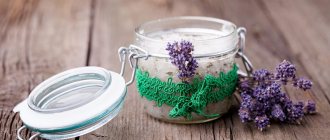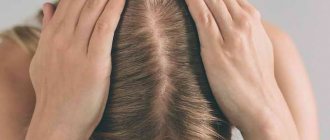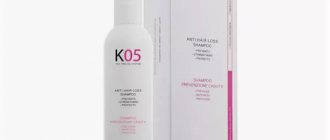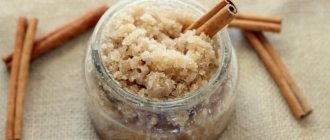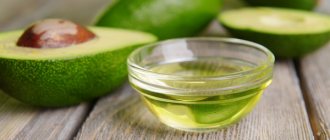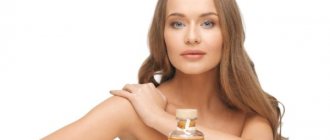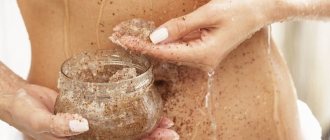Last update: 02/27/2021
Author of the article:
Menshchikova Galina Vladimirovna
Dermatovenerologist, trichologist, candidate of medical sciences, member of the Association “National Society of Trichologists”
We exfoliate the face and body, but what about the scalp? The skin is the largest human organ, but many people forget that the scalp needs care no less than the face or body. Meanwhile, trichologists draw the attention of women to the need for deep cleansing in this area. Let's talk about the benefits of peelings for the scalp and share recipes for scrubs.
The benefits of scrubs for the scalp
Due to the presence of abrasive and additional components in the composition, the scrub brings the following benefits:
- Absorbs sebum and normalizes the secretion of the sebaceous glands.
- Removes dead skin particles.
- Reduces hair loss.
- Provides access to oxygen to hair follicles.
- Promotes hair growth.
- Removes residues of hair tonics, masks and other products from the scalp.
- Increases blood flow to the scalp, due to which the hair receives more nutrients and gains shine, strength, and strengthens.
- Enhances the effectiveness of hair masks if you carry out the procedure before applying them.
Ready-made products
Manufacturers of hair care cosmetics could not ignore salt peeling, so ready-made formulations can be purchased on the shelves of specialized stores:
- Salon SPA Collection. The company offers customers several salt-based products at once. Each of them performs its own function, for example, stimulating renewal processes. The products are suitable for all skin types.
- Mayur. Salt scrub with lavender. The product has cleansing, moisturizing, nourishing and softening properties. The product line also includes salt hair scrubs (only positive reviews about them) with the addition of rose, orange, verbena, ylang-ylang, and lemon oils.
- Peeling shampoo for scalp and hair Indola. Helps remove excess oil, dandruff, hair care and styling products. The shampoo is based on lemon grass and jojoba extract. Salt was used as a peeling base. In addition, the composition includes hydrolyzed keratin, panthenol, zinc pyrithione.
- Scrub from. This is a salt-based sea buckthorn product. It helps cleanse the scalp and roots of fat and dirt, as well as regeneration, accelerate hair growth and restore it.
Salt hair scrub is a natural, affordable remedy that can solve many scalp problems. By exfoliating dead dermal cells, you can normalize blood circulation in this area, stimulate hair growth, make it stronger and shinier.
What salt to use
Both table and sea salt can be used as a scalp scrub, but sea salt is best due to the fact that it has a rich mineral composition.
If regular salt contains only sodium chloride, then sea salt contains:
- iodine;
- magnesium;
- iron;
- phosphorus;
- manganese;
- selenium;
- calcium;
- zinc;
- potassium and others.
How it works
The problem of many women is excessive hair loss, fragility and split ends. It is salt (sea and table salt) that cosmetologists use to treat hair loss and to activate hair growth.
The fact is that it improves blood supply to areas of the scalp, which ensures the “delivery” of all useful elements entering the blood along with food. In addition, the white crystals themselves are rich in minerals, so penetrating into the upper layers of the skin, they are perfectly absorbed and reach the follicle, strengthening the hair from the inside.
Salt grains contribute to:
- activation of curl growth;
- improving microcirculation of the skin;
- eliminating white flakes called dandruff;
- absorption of sebum (sebum secreted by the sebaceous glands);
- less hair loss;
- beautiful shine and well-groomed appearance of your hair.
It will be useful for you to know: how hair grows on the head, growth phases.
Interesting moment! Salt has an antibacterial effect on the root zone of our hair. That is why it is included in numerous masks that fight dandruff and other diseases associated with the proliferation of bacteria and fungus.
Beneficial features
Small fractions of salt massage the scalp, which improves microcirculation. If you add salt to your masks or regularly rub in the grains from time to time, you will soon see how your hair has become thicker, regained its natural shine and strengthened from the inside.
The fact is that salt is a kind of abrasive that can improve the penetration of beneficial substances into the layers of the epidermis. Therefore, if you successfully combine the crystals of this wonderful product with oils, juice, decoctions of medicinal herbs and other healing agents, you will improve the penetration of their vitamins and microelements into the hair follicle itself.
Iodine and chlorine are the main components of salt. They remove moisture, so if you have dry hair, it is not recommended to use salt in its pure form. In addition, to prevent over-drying, be sure to moisten your hair with regular warm water.
Sea salt contains:
- sodium, responsible for regulating the water balance of the dermis;
- potassium, which acts as a protective barrier against moisture evaporation;
- magnesium, which normalizes blood circulation;
- calcium is a well-known building material on which the quality of curls directly depends;
- strontium, which strengthens hair roots;
- bromine, which adds shine and elasticity in combination with other beneficial components of masks.
White sand is recommended for those who suffer from alopecia (hair loss), dandruff, and excessive oily skin. By improving the functioning of the sebaceous glands, less sebum is released, so your hair will delight you with its cleanliness for a long time.
Regular salt has only 2 useful substances - sodium and chlorine. But sea salt contains up to 65 microelements.
Effect on hair
Many girls are surprised how salt can have a beneficial effect on the structure of their hair, because those who have swum in the sea at least once know that it only harms their hair? In fact, the curls are harmed by the saline solution, which dries under the influence of UV rays.
Salt, rich in minerals and iodine, exfoliates the skin of the hair and also nourishes the hair follicle. Due to this, the curls gain strength, elasticity, stop falling out and split less.
We recommend reading: what affects the speed of hair growth.
Please note that a common cause of hair loss is dandruff. The fact is that white scales prevent normal access of oxygen to each hair. Eliminating dandruff mechanically is just possible through gentle peeling with sodium chloride.
Selecting the type of salt
You can take regular table salt, but it is better to buy sea salt, which is richer in microelements.
Fractional fractions of salt (you will need to crush the product purchased at the pharmacy a little) can be rubbed into the scalp. Cosmetologists also recommend making a simple but effective solution based on sodium chloride - take a heaped teaspoon of crystals for 1 glass of water, and thoroughly chop the resulting mixture with a fork in a glass.
Contraindications
Unfortunately, salt cannot be called mild. If you overdo it with the amount or massage the scalp too actively, you risk harming the skin.
The only contraindication is the presence of wounds on the skin, penetrating into which salt can corrode them even more.
Oil-salt scrub
You need to take 2 tbsp. salt and some basic cosmetic oil, such as avocado, almond, olive. After mixing the ingredients so that they turn into a thick mixture of paste-like consistency, apply them to the root zone of the hair. Application begins from the occipital part, then moves to the parietal part.
After application, massage your scalp with your fingers for a few minutes and then rinse your hair with shampoo.
The scrub is applied to dry or damp hair. Moreover, in the latter case, the scrub will have a more gentle effect on the scalp.
Types of peeling
There are several types of exfoliation that are used, including for the scalp:
- mechanical - scrubbing with abrasive agents;
- chemical - peeling with acids (glycolic, salicylic, lactic, mandelic, etc.);
- hardware - in relation to the scalp, procedures such as gas-liquid and galvanic peeling are carried out.
Mechanical cleaning involves the use of compounds with natural abrasives, which provide exfoliation.
If we talk about chemical peeling, then only superficial cleaning is used for the scalp. To avoid damaging the hair follicles, preparations with a low concentration of active acids are used. A weak acid solution gently exfoliates dead cells from the surface without penetrating into the deeper layers.
Gas-liquid peeling is a non-contact procedure in which the effect occurs using compressed gas and liquid in the form of a therapeutic solution. The method is based on the use of a high-speed two-phase flow of medical gas (carbon dioxide and oxygen) and fine liquid. In addition to exfoliation and cleansing, the beneficial effect of the procedure is achieved through pressure jet massage, cryotherapy and oxygenation. Jet gas-liquid skin treatment is suitable for those who wish to conduct non-injection mesotherapy. For this procedure, vitamins, peptides, hyaluronic acid or antibiotics are used.
Galvanic peeling is a procedure that combines the effects of galvanic current with peeling serums. It is performed with a special comb with electrode teeth using a composition previously applied to the skin.
Indications and contraindications for the procedure
Scalp peeling is indicated for:
- seborrhea;
- dandruff;
- oily hair;
- hair loss.
By the way, this procedure is indicated for both women and men. Without a doubt, exfoliation is very beneficial, but it has limitations. Peeling cannot be done in the following cases:
- microcracks and other damage to the skin;
- sensitive skin;
- eczema, psoriasis;
- professional chemical peels are not recommended during pregnancy and breastfeeding;
- allergic reaction to acid.
Professional peelings
Today, many well-known cosmetic brands produce various professional peelings for the scalp. The composition of the products may include AHA acids, natural oils and extracts. Exfoliating products are available in the form of creams, mousses, and gels. They can be freely purchased at a beauty salon, in specialized stores or at a pharmacy and used independently at home.
Modern dermatological peelings for the scalp are not only a means of chemical exfoliation, but are also used in the prevention and correction of seborrhea, hair loss and other problems. This is why peeling in hair restoration salons and trichology clinics is often used to prepare the skin for more specialized treatments such as mesotherapy.
How to do scalp and hair peeling in a salon
You can sign up for a chemical peeling procedure for your head at a salon or cosmetology clinic that has a trichology department. At the clinic, the trichologist will initially diagnose the scalp and hair condition.
Depending on the client’s skin type and the existing problem, the specialist will select the optimal drug for chemical exfoliation in the required concentration. The composition is applied along the partings to a damp and clean scalp and hair roots, for which the hair is first washed with a neutral shampoo. After 5-15 minutes, a neutralizer is applied. Then the hair is washed and dried with a hairdryer.
A specialist can suggest a mask for your hair type for the final stage. It is possible to combine the procedure with a head massage.
As a rule, salon procedures are recommended to be carried out in a course. If you don't want to spend money and time visiting salons, this treatment can be done at home.
Home peeling recipes
There is nothing easier than preparing scalp peeling at home. The easiest way to quickly cleanse the scalp of impurities and sebum is to use sea salt, which is rich in various microelements: iodine, calcium, iron, sodium, zinc, etc. But other abrasive components can also be used: table salt, sugar, coffee, soda . To prevent irritation and dryness from peeling, softening and moisturizing ingredients are added to the scrub, such as oil, kefir, egg yolks, etc. With such cleansing, the scalp will also receive nourishment.
Cleansing the skin with scrubs at home does not require large financial costs, does not take much time, and is technically very simple.
General recommendations:
- For salt peeling, choose finely ground salt, because large fractions can severely scratch the skin. Coarse salt can be ground in a blender or coffee grinder;
- apply peeling only to damp hair and exclusively in the root zone;
- wash your hair after peeling, not before;
- if the homemade scrub contains nutritional components, after the massage it can be left on the hair as a mask for 10-15 minutes with insulation with a cap and towel;
- for oily hair, the optimal frequency of the procedure is 2 times a month; for dry hair, it is enough to scrub once a month;
- Calculate the amount of ingredients for a homemade scrub depending on your hair length.
Be careful: dyed hair from the scrub may lose its color brightness; it is better to use store-bought peelings for it.
Recipe 1. With salt
- 1 tbsp. l. finely ground sea salt
- water
- 3 drops essential oil
Combine sea salt and room temperature water in a 1:1 ratio, stir until the consistency of liquid sour cream. Instead of water, you can use hair balm; give preference to natural balms. Add a couple of drops of essential oil suitable for your problem. For example, lavender, lemon, and tea tree oils are recommended for oily hair and dandruff; jasmine, chamomile or rose oils are suitable for dry hair. Apply the mixture gently along the partings and then massage the skin for a few minutes. After this, wash your hair as usual.
Recipe 2. With sugar
- 1 tsp. Sahara
- ½ tsp. olive oil
Mix the ingredients and massage your scalp with this mixture for a few minutes, then rinse.
Recipe 3. With clay
- 3 tbsp. l. finely ground table salt
- 2 tbsp. l. any clay, for example blue
- 1 tbsp. l. Water
Combine salt and clay and add water to the container. The resulting mixture is applied to the scalp with massage movements, then rinsed off.
Recipe 4. With coffee
- 2 tsp. coffee grounds
- 1 egg yolk
- 1 tsp. liquid honey
- 1 tsp. lemon juice
Apply a mixture of these ingredients to your scalp with massaging movements. Leave on for a few minutes, then rinse with warm water and organic shampoo. To prepare this scrub, you can use coffee grounds, coffee cake or ground coffee. The grounds and cake have a softer, more delicate effect.
Please note: coffee is a natural dye, so fair-haired girls are advised to choose a different scrub to avoid darkening of the roots.
There are many other homemade hair peeling recipes. Choose the one you like best, or come up with your own: the main thing is to dilute the abrasive with a liquid (water, herbal infusions, green tea, mineral water); you can add a few drops of essential oil suitable for your problem to any recipe.
To consolidate the effect, use high-quality hair cosmetics, preferably with the most natural composition. For example, shampoo, conditioner and care mask can be selected from the ALERANA® line. Shampoos and hair strengthening balm contain natural oils and growth stimulating extracts, as well as other useful components necessary for nourishing and restoring hair, the effectiveness of which has been proven in clinical studies. ALERANA® intensive nutrition mask, enriched with wheat proteins, plant extracts, jojoba oil, nourishes and heals hair follicles and hair along the entire length.
Cleansing the scalp while nourishing and restoring the hair will give the best results!
Recipe with clay
Clay has absorbent properties, so when combined with salt, the mixture has an even greater cleansing effect. With the help of such a scrub, you can not only cleanse your hair of excess oil once, but also normalize the secretion of skin secretions. For preparation you will need: water, clay, salt. Proportions: 3:1:3.
Head scrub with salt and clay is easy to prepare and easy to use
First you need to mix the dry ingredients and then add water to them. It is better to do this gradually, achieving the desired consistency. The composition should be thick enough so that it does not drip from the hair. Hair must be moistened before applying the product.
After applying the mixture, do a light massage of the root zone for 5 minutes and leave the scrub for about 10 minutes. Then wash your hair with shampoo and warm water.
Hair masks with sea salt
It is very good to do skin care masks after a salt head massage. Salt improves the penetration of nutrients from masks, which increases their effectiveness significantly.
Vitamin mask
- 1 ampoule of nicotinic acid
- 1 ampoule of pharmaceutical aloe extract
- 1 tablespoon salt crystals
- 1 tablespoon liquid honey
Mix the ingredients and apply to the roots with light massaging movements.
Leave the mask on for 30-40 minutes. After this time, rinse with warm running water.
For another use of nicotinic acid for hair growth and hair loss, read the article NICOTINIC ACID FOR HAIR.
Mask to stimulate growth
- 1 tablespoon salt crystals
- 1 tsp. spoon of cognac
- 1 teaspoon honey
Mix the ingredients and apply to the roots. Give a light massage for at least 5-7 minutes.
Wrap your head in cellophane and a warm towel. Leave the mask on for at least 30 minutes, then rinse with warm running water.
Don't be alone with your problem! You are not the only person experiencing hair loss.
Effective methods have been developed for hair loss and to stimulate hair growth. This method once helped me restore hair growth (about 60% of my hair fell out) completely! FIND OUT MORE...
Mask for oily hair
- 1 tablespoon of colorless henna
- 1 table. spoon of salt
- 0.5 cups of burdock decoction
Brew colorless henna with burdock decoction and let it brew for about 10 minutes. Add salt crystals to the resulting mixture. Apply the mixture to your curls and wrap your head with cellophane and a towel.
The exposure time of the mask is at least 1-1.5 hours. After this, rinse the mixture with warm running water and shampoo.
How to use colorless henna to solve hair problems, read the article COLORLESS HENNA FOR HAIR.
Additive to shampoos
Add sea salt to your shampoo before washing your hair.
Pour the required amount of shampoo into your palm and add a teaspoon of fine sea salt to it. Mix with your finger and apply to the hair roots and massage to form a thick foam.
After the massage, rinse off the shampoo and rinse your hair with a saline solution.
Salt rinse
Salt rinsing is an excellent antiseptic and will prevent the appearance of fungal diseases and get rid of dandruff, and protect curls from falling out.
The simplest and most effective way is to dilute a teaspoon of sea salt in a glass of herbal infusion.
Rinse your hair with this solution after washing your hair, pat dry with a towel and leave for about 10-15 minutes. After this, rinse with warm water and dry as usual.
Add sea salt to your favorite homemade hair masks and you will get excellent results in the form of healthy and shiny hair!
With aloe
Aloe juice moisturizes not only the scalp, but also the hair, making it silky and manageable. Salt must be combined with aloe juice. The juice is squeezed from the fresh leaves of the plant.
It is best to harvest leaves from an old plant, no younger than three years old. An older plant has more nutrients. There is no specific proportion; you need to ensure that the composition is convenient to apply to your head.
Distribute the composition with massage movements over the scalp, and then rinse off after a while.
With cognac
Experts recommend doing a scrub with cognac for those who have dry hair. This recipe is ideal for the winter season.
You need to mix 3 tbsp. salt, almond oil (you can use something else) and cognac. Add yolk and 1 tbsp to the mixture. honey Mix thoroughly.
You should get a fairly thick mass. It should be applied to the hair and scalp, distributed with massage circular movements and left for 10 minutes. Then the composition is washed off with shampoo.
How to choose hair peeling?
When choosing a specific peeling product, you need to be guided by the result you want to achieve. Scrubs are divided according to the method of action, but the effect from them is almost the same. Physical means are the most common. These include all types of scrubs. Chemical ones contain enzymes and acids - salicylic, lactic, glycolic, almond, etc. The choice depends on how deep cleansing the scalp requires.
Choose peeling in the Maroshka online store
With kefir
A head scrub made from salt and kefir is recommended if your hair is dry. Kefir-salt scrub cleanses the hair and scalp gently, while at the same time kefir gives a moisturizing and nourishing effect.
To prepare, you need to take high-fat kefir, mix it with some salt - look at the consistency. After a course of applications, the hair becomes silky, manageable, and strong.
Choosing an abrasive base for the product
Not every sea salt is suitable for making a head scrub at home (by the way, only sea salt can be used for this purpose; table salt is not suitable). You should not take salt, which is in the form of large crystals, as they can injure the scalp without bringing any benefit. Specialized stores offer a finely ground product. If you couldn’t find such salt, you can grind it at home.
With pepper
Salt and pepper scrub is an aggressive mixture and is not recommended for use if your scalp is sensitive. Mix 2 tbsp. salt with 1 tsp. red pepper and 1 tsp. cinnamon. After mixing the dry ingredients, add any cosmetic oil to the composition, for example, avocado, almond, olive, sea buckthorn.
After application, the mixture will burn, but the sensations should be tolerable; if they become too painful, the composition should be washed off.
Contraindications to the procedure
Salt peeling is not recommended if you have:
- weak thin hair;
- dry and sensitive scalp;
- various skin pathologies, for example, psoriasis;
- microdamage to the skin.
Salt peeling should not cause any discomfort. Therefore, if itching, irritation or redness occurs, you should refuse to continue the cosmetic procedure.
With onion
A strengthening scrub made from sea salt and onion. Onions have irritating properties, so they are optimal for stimulating hair growth. You need to take ½ tbsp. salt, preferably sea salt, and 1 onion.
A mixture of onion and salt accelerates hair growth and makes it thicker
The onion should be thoroughly chopped in a blender to a paste. The resulting mass is mixed with salt. Heat a little until warm, and then rub into the scalp. Leave the mixture on the hair for 20 minutes and then rinse with water.
Indications for use
A salt scrub effectively copes with various cosmetic problems that arise with the hair and scalp. This product is recommended for oily, normal hair ; it can also be used for dry and fine hair, taking precautions.
Salt scrubbing should be included in the complex of procedures if the following problems arise:
- excessive activity of the sebaceous glands;
- the appearance of dandruff;
- mechanical contamination of the head;
- lack of shine and slow hair growth.
With soda
After using a soda-salt scrub, the hair becomes softer, fresher, the scalp is cleansed, and the hair stays clean longer.
To prepare, you will need sea salt and baking soda in equal proportions. The quantity is taken at your own discretion. You can dilute the dry ingredients with plain water or a herbal decoction, such as nettle or chamomile. After application, keep the composition on your head for 10 minutes, then rinse off.
A collection of benefits of salt cleansing
On the one hand, it seems that such a simple cleansing as scrubbing with sea salt has no more effect than, for example, coffee. But this is far from true. The result of home salt peeling for scalp renewal is comparable to many professional salon procedures. Knowing this, large cosmetic companies produce ready-made mixtures for this type of peeling.
Peeling based on sea or iodized salt:
- regulates the secretion of sebaceous glands;
- carefully removes all dirt deposits;
- stimulates blood microcirculation in the epidermal layer, activates intercellular metabolism;
- provides better oxygen supply to hair follicles, activates saturation with micronutrients;
- relieves clogging of scalp pores, releasing hair follicles;
- stimulates hair growth;
- eliminates the “snowy shoulders” complex, helping to eliminate dandruff;
- helps to forget about increased greasiness of hair;
- dries out the skin;
- improves the healing of inflammation;
- eliminates the feeling of itching;
- prevents seborrhea and helps in getting rid of it;
- at the end of the session it gives a feeling of freshness and a “light head”.
Peeling for hair growth has a low cost - it varies within a few hundred rubles. The ingredients for preparing the composition are enough for more than one use. Therefore, it is most convenient to prepare a salt hair peeling from improvised means and do it at home.
Essential oils in salt scrub
By adding essential oils to a salt scrub, you can eliminate dandruff, prevent hair loss, and moisturize and nourish strands.
| Strengthening | Moisturizing | Fat-removing | Anti-fall | Anti-dandruff |
| Burdock | Rose | Melissa | Pine | Lavender |
| Sage | Mint | Cedar | Tea tree | |
| Chamomile | Lavender | Tea tree | Orange | |
| Jasmine | Ylang-ylang | Lemon | ||
| Lemon | Geranium | |||
| Grapefruit |
Tips for using a salt scrub
- A salt head scrub dries out the skin very much, so if you have dry skin, it is recommended to use it no more than once every 2 weeks. If your scalp is oily, you can do it 2 times a week.
- Experts recommend course use of the scrub, i.e. about 7-10 procedures. After which you need to take a break.
- If your hair is oily at the roots and dry at the ends, in order not to dry out the hair and make the ends even drier, before using the scrub, it is recommended to apply olive oil to the lower third of the length of the hair.
- Scalp massage should be performed from the back of the head to the parietal area. This technique is the most correct from the point of view of massage lines and stimulation of blood circulation: the hair becomes stronger, its growth is stimulated, and headaches are calmed.
- If your hair is dry or there are any problems with your hair or scalp, such as dandruff or split ends, you should add essential oils to your scrub. They will enhance the effectiveness of the mixture, nourish the hair with useful substances, and give the hair a pleasant aroma.
- Salt scrub has a more intense effect at high temperatures, so it is especially recommended for use in a bath. Salt masks are allowed. To do this, the composition must be left on the hair for some time after scrubbing the skin (usually 10 minutes), wrapping the head in plastic and a towel.
- In addition to using a salt scrub, it is recommended to use moisturizers to avoid drying out your hair. It is desirable that these are also homemade products.
- The scrub must be washed off first with water and then with shampoo. If you don't use shampoo, salt crystals will remain on your hair.
Beneficial features
Salt improves the condition of the scalp, making it healthier. By removing dead cells, hair follicles are activated and hair begins to grow faster
This is especially important for those who have oily hair and have to wash their hair frequently.
Salt promotes the normal functioning of the sebaceous glands of the skin. Consequently, hair no longer needs frequent washing.
If the scalp is excessively dry, then salt masks should not be used; the skin may begin to peel, which will negatively affect hair growth and appearance.
For use in homemade masks, regular salt, which can be purchased at the grocery store, is suitable. You can take regular table water, or you can take iodized one. But the sea one is especially good for these purposes. It is saturated with useful minerals and trace elements.
Also a good solution would be to use sea salt for hair growth, to which seaweed or essential oils are added. This salt nourishes the scalp well, removes dead skin particles and makes it healthy.
Did you know that some procedures can accelerate the growth of strands, such as mesotherapy and scalp massage?
It is also very important to comb properly
Disadvantages and contraindications
Salt scrub has contraindications:
- It should not be done if there are scratches or wounds on the scalp. Salt causes a burning sensation when it enters an injury. If you still need to make a scrub, the salt should be replaced with another abrasive.
- If severe baldness is observed, hair may begin to fall out even more intensely, because weakened follicles are not able to withstand the serious mechanical impact that a salt scrub has.
- With the systematic use of a scrub, the pigment is washed out faster from colored hair.
- Contraindications include skin diseases, such as eczema and psoriasis.
- Salt may cause an allergic reaction.
- Dry hair with split ends should not be exposed to a scrub more than once every two weeks, but even in this case, you need to protect your hair with oils.
Salt scrub is a convenient and affordable product that is used to nourish hair, remove dead skin particles, stimulate blood circulation and hair growth.
It can dry out the skin, however, if you follow the recommendations and use moisturizing and nourishing products after the scrub, this deficiency will be eliminated. Salt scrubs are especially suitable for oily scalps.
Who shouldn't do it?
But in the following cases, scrubs with added salt can cause significant harm, so avoid them if:
- you have wounds, scratches and other damage to the scalp - it will be very unpleasant;
- you have severe baldness - weak follicles will not be able to hold thin hair due to mechanical stress;
- you are allergic to salt in general - it happens, but quite rarely;
- hair is overdried, split in length - salt will only aggravate the problem, remember how long it takes to restore hair after swimming in the sea;
- you have increased sensitivity of the scalp - in this case, unwanted irritation may occur; it is better to replace it with another component.
That's all! I advise you not to forget to deep cleanse your scalp with scrubs. If you have never tried it before, do it and you will immediately feel the difference before and after. Trichologists also recommend hair scrubs; they will be especially beneficial for oily scalps.
Have healthy hair! See you!


